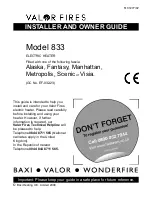
Mighty Max Volume Water Heater
Page 19
WHAT TO DO IF YOU SMELL GAS
·
Do not try to light any appliance.
·
Do not touch any electric switch; do not use any
phone in your building.
·
Immediately call your gas supplier from a
neighbor’s phone. Follow the gas supplier’s
instructions.
If you don’t smell gas, go to the next step.
7.
Turn on manual gas valves.
8.
Reset all safety devices (manual resets on high
limit, low water cutoff, etc.).
9.
Replace control access panel.
10.
Turn on all electric power to the boiler.
11.
Set thermostat to desired setting.
12.
If the boiler will not operate, follow the
instructions to turn off gas to heater and call
your service technician or gas supplier.
a.
Turn off main electrical switch.
b.
Close all manual gas valves.
3D-1. Setting Temperature Controls
To set the temperature and high-limit controls:
a.
Set the temperature controller at the system
design temperature.
b.
For heaters with the temperature controller bulb
at the heater inlet, set the high-limit 40ºF to 50ºF
above temperature controller setting.
c.
For heaters with the temperature controller bulb
at the heater outlet, set the high-limit 15ºF to
25ºF above temperature controller setting.
3E. To Shut Down System
To shut down the boiler, turn off all manual
gas valves and electrical disconnect switch.
NOTE: There is a filter which needs to be cleaned
prior to setting pressures. See section labeled “Filter
Service” before proceeding
3F. Venturi Combustion Flow System
Verifying proper operation of the combustion
flow system has two aspects - air flow and gas flow.
Air flow is checked by measuring pressures at service
taps on the venturi. Gas flow is checked by evaluating
venturi pressures and the regulator offset pressure.
In a venturi flow system the difference between
various pressures is far more important than their
“gauge” value relative to the room. The gas pressure
offset and the gas orifice pressure differential are
especially important concepts. The following section
describes this setup procedure.
5.
Leaving the positive side of the manometer
connected to the venturi inlet tap (blue), connect
the negative side of the manometer to the shutoff
valve on the gas orifice tap (red). Open the
shutoff valve to take a pressure reading. This
reading is called the gas pressure offset. Using
the regulator only, adjust the gas pressure offset
according to the installation's altitude in Table 5
(+0.4" w.c. at sea level). REPLACE THE
REGULATOR CAP BEFORE TAKING GAS
PRESSURE READINGS. Turn the regulator
screw clockwise to decrease the gas pressure
offset, turn the regulator screw counter-
clockwise to increase the offset.
6.
Using the toggle switch, turn the heater off. Turn
the heater back on and check the gas pressure
offset after the heater has fired. If the gas offset
pressure is not according to Table 10, adjust the
regulator as needed.
7.
While the heater is still running, close the
shutoff valve on the gas orifice tap (red), then
remove the manometer hose from the shutoff
valve. Connect the negative side of the
manometer to the shutoff valve on the venturi
throat tap (yellow). This reading is called the
venturi throat differential pressure and should
appear according to altitude in Table 10 (+2.6"
w.c. at sea level). If it does not appear according
to Table 10, contact a qualified service
technician.
After setting all pressures, turn the heater off and
replace each shutoff valve with the factory installed
threaded plugs. The venturi has now been adjusted for
proper operation.
3D. To Start Up System
(See Section 3A for Startup Requirements)
1.
Be certain the system pump is running.
2.
Set the thermostat or aquastat to its lowest
setting.
3.
Turn off electric power to the appliance.
4.
Remove the control access panel.
5.
Turn off the manual gas valve.
6.
Wait five (5) minutes to clear out any gas, then
smell for gas, including near the floor. Be sure to
smell next to the floor because some gas is
heavier than air and will settle on the floor.
Caution
This appliance is equipped with an ignition device
which automatically lights the burner. Do not try to
light the burner by hand.
Summary of Contents for Mighty Max VW Series
Page 25: ...Mighty Max Volume Water Heater Page 25 Figure 19 Troubleshooting Chart...
Page 27: ...Mighty Max Volume Water Heater Page 27 Front View Right Side View...
Page 28: ...Page 28 LAARS HEATING SYSTEMS Front View Rear View Right Side View Left Side View...














































